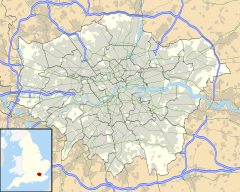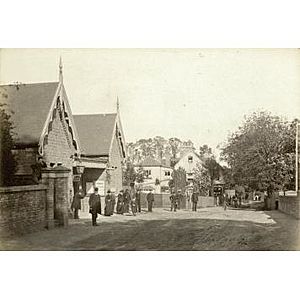Winchmore Hill facts for kids
Quick facts for kids Winchmore Hill |
|
|---|---|
| OS grid reference | TQ315945 |
| London borough | |
| Ceremonial county | Greater London |
| Region | |
| Country | England |
| Sovereign state | United Kingdom |
| Post town | LONDON |
| Postcode district | N21 |
| Dialling code | 020 |
| Police | Metropolitan |
| Fire | London |
| Ambulance | London |
| EU Parliament | London |
| UK Parliament |
|
| London Assembly |
|
Winchmore Hill is a lovely area in North London, part of the Enfield borough. It's known for its beautiful green spaces and friendly community. This area is about 14 kilometers (9 miles) north-east of Charing Cross, a famous spot in central London.
Winchmore Hill is centered around its special conservation area. It has clear boundaries: to the east, you'll find Green Lanes (a main road called the A105 road), Barrowell Green, Firs Lane, and Fords Grove. To the north-west, it borders Grovelands Park. In the south, it reaches part of Aldermans Hill, and in the north, it goes up to Vicars Moor Lane and Houndsden Road.
Contents
Discovering Winchmore Hill's Past
Winchmore Hill was once a tiny village within the larger area of Edmonton. Today, it shares borders with other London neighborhoods like Palmers Green, Southgate, Edmonton, and Grange Park.
Early History and Name
Long ago, even before the Romans arrived in Britain, the Catuvellauni tribe lived in the areas we now call Hertfordshire, Essex, and Middlesex. People believe this tribe built a hill fort on a mound where the Bush Hill Park Golf Club is today.
The first time Winchmore Hill was written about was in a document from the year 1319. Back then, it was spelled Wynsemerhull. The old English words 'merhull' mean 'boundary hill'. So, the name might have meant 'Wynsige's boundary hill'. Over time, the name changed a bit: by 1395, it was Wynsmerhull, and by 1565, it was Wynsmorehyll. By 1586, it was finally called Winchmore Hill, just as we know it today.
Historic Buildings and Places
Winchmore Hill has many buildings with interesting histories.
- Quaker Meeting House: The first religious building recorded here was the Quaker Meeting House, built in 1688 and then rebuilt in 1790. Many important people are buried there, including Luke Howard, who is known as the father of modern meteorology (the study of weather). Also buried there are Alice Hum, who started Palmers Green High School for Girls, and members of the famous Hoare and Barclay banking families. Samuel Hoare was a key person in the fight against the slave trade.
- St Paul's Church: St Paul's Church was built on land given from the Grovelands estate. Its ceiling was once thought to be the largest unsupported plaster ceiling in Europe! This means it didn't have visible poles or beams holding it up until it was updated in the 1960s.
- Old School Buildings: You can still see the original wooden school building for St Paul's School a little way down Church Hill. Parts of the second school building, made of brick and stone, are now part of the church car park walls. The current school building was built in the 1960s and is on Ringwood Way.
- Wades Hill Cottages: On Wades Hill, which goes north from The Green, you can find some old wooden cottages. Further along, there's a tall, five-story house from 1710. It looks like the grand Georgian townhouses you'd see in London's West End, but it stands alone. It used to have a twin house next to it, which was sadly taken down before such old buildings were protected by law.
Famous Old Pubs
- The Green Dragon: This was probably the oldest pub in the area, opening around 1726 on Green Lanes. It's said that a highwayman (a robber who attacked travelers on roads) was caught and executed on gallows right outside the pub! These gallows stayed there for years, which might have made the owner move the pub to its current spot near the end of Vicars Moor Lane in the late 1700s. The original building was pulled down in 1892, and the new one was changed a lot in 1935. It stopped being a pub in 2015, but the building is still there.
- The Woodman: Near Broadwalk, The Woodman pub is thought to have been built in 1727, though some evidence suggests 1820. Before it became a pub in 1868, it was a private home.
- Other Old Homes: Woodside House and Rowantree House on The Green, built in 1750, are made of painted brick. Many other local homes built between 1770 and 1839 are still standing today. Near the Dog and Duck on Hoppers Road, you can see some old terraced houses from around 1770. Number 106A Vicars Moor Lane is a unique private house that used to be a chapel.
How Transport Changed Winchmore Hill
- The Railway Arrives: In 1865, the Great Northern Railway got permission to build a new train line. This line would go from Wood Green to Hertford, passing through Palmers Green and Enfield. However, because of money problems in 1869, they decided to make Enfield the end of the line for a while. Palmers Green and Winchmore Hill were planned as small stations along the way.
The company wanted to finish the line to Enfield by 1870, but the land was harder to build on than they thought. Five workers even lost their lives while laying the tracks. The train line finally opened on April 1, 1871. The first passenger train came through Winchmore Hill, which helped turn the area into a new suburb of London. At first, only 16 trains a day left Enfield, mostly heading to Moorgate.
- Electric Trams: In 1907, an electric tramway was built along Green Lanes from Palmers Green. This also helped the area grow even more. The tramway is gone now, but the road is still wide. The 329 bus (which used to be the 29, and before that the 123) still follows the old tram route from Enfield to Turnpike Lane.
- The Capitol Cinema: The Capitol Cinema was a beautiful movie theater designed in the Art Deco style. It opened on December 29, 1929, on Green Lanes. Today, an office building called Capitol House stands in its place. The cinema was run by ABC Cinemas from 1930 until it closed on December 5, 1959, and was torn down the next year.
Winchmore Hill Today
At the very center of Winchmore Hill is The Green, a lovely village green surrounded by shops and restaurants. Winchmore Hill also has a special street called Broad Walk, which has been home to many famous and wealthy people.
Grovelands Park
A very important place in Winchmore Hill is Grovelands Park. This park was once part of a private estate. In 1913, some of the land was sold to the local council to become a public park. The part that stayed private is now home to the Priory Clinic.
Sports and Community
The Winchmore Hill Sports Club is a great place for the community. It offers facilities and teams for many sports, including cricket, football, tennis, hockey, and table tennis.
Winchmore Hill is part of the Enfield Southgate area for Parliament. Some people believe that in the 1997 General Election, the local Member of Parliament, Michael Portillo, lost his seat partly because there was a plan to build a McDonald's restaurant in Green Lanes. The restaurant was never built, and now modern apartments, a Tesco Express store, and an ESSO service station are on that site.
Population Information
In 2001, Winchmore Hill had 12,225 people living in 4,976 homes. Most homes (80%) were owned by the people living in them. The population here was generally a bit older than in the rest of Enfield.
By the 2011 census, the population of Winchmore Hill was 13,403. About 76% of the people were white (54% British, 18% Other White, and 4% Irish). The nearby Bush Hill Park area also had a similar population.
Nearby Places to Explore
- Southgate
- Grange Park
- Palmers Green
- Enfield Chase
- Cockfosters
- Edmonton
- Oakwood
- Enfield Town
- Bush Hill Park
Winchmore Hill in the Arts
Winchmore Hill has even inspired artists and writers!
- The composer Juan María Solare, who was born in Argentina, wrote a piano piece called Winchmore Hill in 2001.
- Many books have been written about the area, including:
- The Cresswells of Winchmore Hill by Peter Hodge
- A History of Winchmore Hill by S. Delvin
- Winchmore Hill: Memories of a Lost Village by Henrietta Cresswell
- Memories of Winchmore Hill by Horace G Regnart
- Fond Memories of Winchmore Hill by Alan Dumayne
- A Look at Old Winchmore Hill by Stuart Devlin
- Southgate and Winchmore Hill: A Short History by David Pam
- Dr Cresswell's Winchmore Hill published by the London Borough of Enfield Libraries
- The Story of Southgate and Winchmore Hill by "Walker Round" (1906)
Getting Around Winchmore Hill
Train Services
Govia Thameslink Railway runs train services on an electric line that goes from Hertford North through Winchmore Hill station into London. This line connects to the tube system further south at Finsbury Park, Highbury and Islington, Old Street, and ends at Moorgate. The closest London Underground station is at Southgate, which is on the Piccadilly line.
Bus Routes
Several London Buses routes serve Winchmore Hill, making it easy to travel around:
Famous People from Winchmore Hill
Many well-known people have lived in Winchmore Hill, including:
- Emma Bunton, singer (from the Spice Girls)
- James Caan, a successful businessman
- Alfredo Campoli, a famous violinist
- Thomas Carte, a historian
- Alan Dumayne, a local historian
- Thomas Hood, a poet
- Frank Ifield, a singer
- Myleene Klass, a singer and TV presenter
- Norris and Ross McWhirter, who were born here and founded the Guinness World Records
- Keith Moon, drummer for The Who
- Louise Redknapp, a singer
- Elizabeth Sawyer, known for a historical witch trial
- Leslie Smith, a businessman
- Rod Stewart, a famous singer
- Roy Strong, an art historian
- Melanie Sykes, a TV presenter
- Sharon Turner, a historian
- Leslie R. H. Willis, an engineer
- Paul Young, a singer
- Clem Cattini, a drummer



